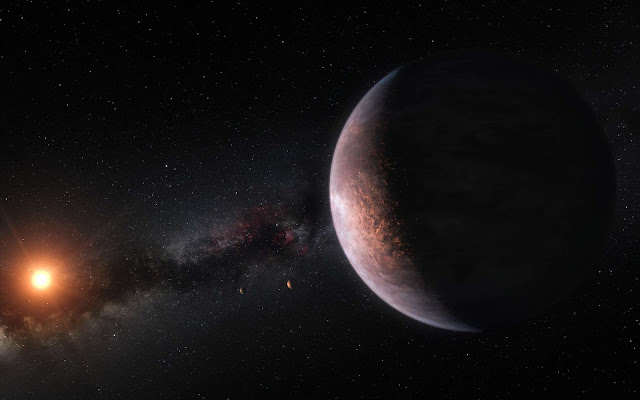NASA - Transiting Exoplanet Survey Satellite (TESS) logo.
Sept. 11, 2022
Image above: Two new super-Earths have been unearthed by an international team of astronomers, both orbiting the star LP 890-9. And one of them would be in the habitable zone! Image Credits: NASA/JPL-Caltech.
Two new super-Earths are added today to the list of exoplanets discovered. Unearthed thanks to the telescopes of the Speculoos project (Search for habitable Planets EClipsing ULtra-cOOl Stars) which consists of looking for habitable planets around faint and cold stars, they orbit around the star LP 890-9, also called TOI- 4306 or Speculoos-2.
This small red dwarf star is located some 100 light-years from Earth, and happens to be the second coldest star around which exoplanets have ever been found! After Trappist-1, the coldest star known to host planets, 7 to its credit! The two new findings were detailed in a study published in the journal Astronomy & Astrophysics.
Orbital periods of 2 and 8 days, yet one of the two is in the zone of habitability
The two planets orbit their star rapidly: the innermost completes a full rotation in just 2.73 days, and the other in 8.46 days! The inner planet, called LP 890-9b, is 30% larger than Earth. Initially detected by NASA's Tess (for Transiting Exoplanet Survey Satellite) space telescope, which detects nearby exoplanets by the transit method, it was then confirmed and then characterized, thanks to Speculoos.
Image above: The Transiting Exoplanet Survey Satellite (TESS) Data Processing Pipeline processes the raw pixels, extracts photometry and astrometry for each target star, identifies and removes systematic errors, flags transiting planet signatures, and performs a suite of diagnostic tests in order to help detect exoplanets. Image Credits: NASA/JPL-Caltech.
"Tess searches for exoplanets using the transit method, by simultaneously monitoring the brightness of thousands of stars, looking for slight obscurations that could be caused by planets passing in front of their stars", explains Laetitia Delrez in a press release, first author of study and postdoctoral researcher at the University of Liège.
“However, follow-up with ground-based telescopes is often needed to confirm the planetary nature of detected candidates and refine measurements of their orbital sizes and properties. Indeed, the Tess telescope is not very sensitive to infrared, and the star LP 890-9 emits mainly in this area.
Image above: Comparison between the LP 890-9 system and the inner Solar System. The LP 890-9 system is much more compact: its two planets could easily fit inside the orbit of Mercury, the innermost planet of our Solar System. Image Credits: Adeline Deward, Rise-Illustration.
As for the second planet, the outermost, it is the one that attracts the most attention from researchers: baptized LP 890-9c and of a size similar to LP 890-9b, it would be located in the habitability zone although it has a very short orbital period: only 8.5 days!
“Although this planet orbits very close to its star, at a distance about 10 times shorter than that of Mercury around our Sun, the amount of stellar irradiation it receives is still small, and could allow the presence of liquid water on the surface of the planet, provided there is sufficient atmosphere, explains Francisco J. Pozuelos, co-author of the study and researcher at the Institute of Astrophysics of Andalusia. This is because the star LP 890-9 is about 6.5 times smaller than the Sun and has a surface temperature half that of our star. This explains why LP 890-9c, despite being much closer to its star than Earth is to the Sun, might still have conditions that support life. »
The term "super-Earth" or "super-Earth" designates an exoplanet whose mass is between one tenth of that of the Earth and 5 times its mass. The term, which is often associated with a rocky planet of a mass similar to Earth, is quite recent; it was introduced in 2002 following the use of "super-earth" in a scientific journal. Although we often speak of a telluric planet located in the habitability zone when we designate a super-earth, the nature of the latter is not necessarily rocky: there are gaseous super-earths!
A prime target for the search for life by James-Webb
This discovery is thus encouraging for the search for life: the star LP 890-9 becomes one of the main targets of choice for James-Webb, after the planets of the Trappist-1 system! According to Laetitia Delrez, it would even be a prime target, especially for the greater chemical traceability of its atmosphere.
Image above: Artist's impression of the Trappist-1 system compared to the Solar System. The surface of each Trappist-1 planet is based on possible physical scenarios. The green zone corresponds to the “habitable zone” of liquid water. Image Credits: NASA/JPL-Caltech.
“This comparison, however, ignores the fact that LP 890-9c is located near the inner limit of the habitable zone and therefore could have a particularly water vapor-rich atmosphere, which would then enhance its atmospheric signals. Moreover, the models often differ as to the exact position of this interior limit of the habitable zone according to the characteristics of the star. The discovery of LP 890-9c therefore offers a unique opportunity to better understand and constrain the conditions of habitability around the smallest and coldest stars in our solar neighborhood,” she concludes.
Related links:
Astronomy & Astrophysics:
https://www.aanda.org/10.1051/0004-6361/202244041
NASA's Transiting Exoplanet Survey Satellite (TESS):
https://www.nasa.gov/tess-transiting-exoplanet-survey-satellite
Images (mentioned), Text, Credits: NASA/Futura Science/Lée Fournasson/Orbiter.ch Aerospace/Roland Berga.
Best regards, Orbiter.ch





